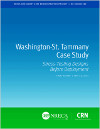Washington-St. Tammany Case Study Stress-Testing Designs Before Deployment - FINAL REPORT
May 15, 2014
NRECA
Craig Miller, Maurice Martin, NRECA
All Smart Grid installations require design review prior to installation. However, several factors make early and rigorous review of communications designs especially critical:
* Communications is an enabling technology for all other Smart Grid functions and devices.
* Radio, wireless, and cellular communications are subject to environmental conditions that vary with geography.
* Radio, wireless, and cellular communications are subject to environmental conditions that vary over time. (Examples of this include weather, solar activity, and interference from industrial operations.)
It helps to have many sets of eyes on a communication design, and utilities must be open to feedback at each step. Sometimes they must make the difficult decision to change designs after implementation has begun. This was demonstrated when Washington-St. Tammany Electric Cooperative ran into a particularly difficult and surprising problem when deploying a communications system intended to connect transmission breakers to its supervisory control and data acquisition (SCADA) system. The problem was unique to the area Washington-St. Tammany serves. However, the need to thoroughly stress-test communication designs is universal. This case study is meant to illustrate that need and highlight the success of that co-ops deployment in the face of unexpected developments.


